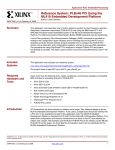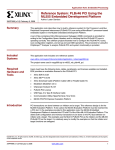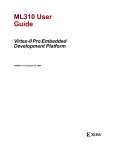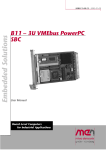Download Xilinx XAPP964 Reference System : OPB PCI Using the ML410
Transcript
fin
Application Note: Embedded Processing
Reference System: OPB PCI Using the
ML410 Embedded Development Platform
R
XAPP964 (v1.1) January 9, 2007
Summary
Author: John Ayer, Jr., Kris Chaplin, Beth Farwell, Ed Meinelt,
Matt Nielson, Lester Sanders
This application note describes how to build a reference system for the On Chip Peripheral Bus
Peripheral Component Interconnect (OPB PCI) core using the IBM PowerPC™ 405 (PPC405)
Processor-based embedded system in the ML410 Embedded Development Platform. The
reference system is Base System Builder (BSB) based and uses eight pcores. This reference
system is similar to the reference system in XAPP911, except with the principal exception that
the ML410 and ML455 boards are used.
A set of files containing Xilinx Microprocessor Debugger (XMD) commands is provided for
writing to the Configuration Space Header and for verifying that the OPB PCI core is operating
correctly. Several software projects illustrate how to configure the OPB PCI core, set up
interrupts, scan the configuration registers, and set up and use DMA operations. The procedure
for using ChipScope™ to analyze OPB PCI functionality is provided. The steps used to build a
Linux kernel using MontaVista are listed. Simulation output files for analyzing basic PCI
transactions are provided.
Included
Systems
This application note includes one reference system:
•
www.xilinx.com/bvdocs/appnotes/xapp964.zip
ml410_ppc_opb_pci is the project name used in xapp964.zip.
Required
Hardware and
Tools
Users must have the following tools, cables, peripherals, and licenses available and installed:
•
Xilinx EDK 8.2.02
•
Xilinx ISE 8.2.02
•
Xilinx Download Cable (Platform Cable USB or Parallel Cable IV)
•
Monta Vista Linux v2.4 Development Kit
•
Modeltech ModelSim v6.1d
•
ChipScope v8.2
© 2006 Xilinx, Inc. All rights reserved. All Xilinx trademarks, registered trademarks, patents, and further disclaimers are as listed at http://www.xilinx.com/legal.htm. PowerPC is
a trademark of IBM Inc. All other trademarks and registered trademarks are the property of their respective owners. All specifications are subject to change without notice.
NOTICE OF DISCLAIMER: Xilinx is providing this design, code, or information "as is." By providing the design, code, or information as one possible implementation of this feature,
application, or standard, Xilinx makes no representation that this implementation is free from any claims of infringement. You are responsible for obtaining any rights you may
require for your implementation. Xilinx expressly disclaims any warranty whatsoever with respect to the adequacy of the implementation, including but not limited to any warranties
or representations that this implementation is free from claims of infringement and any implied warranties of merchantability or fitness for a particular purpose.
XAPP964 (v1.1) January 9, 2007
www.xilinx.com
1
R
Introduction
Introduction
This application note accompanies a reference system built on the ML410 development board.
Figure 1 is a block diagram of the reference system.
OPB
SPI
OPB
INTC
OPB
UART 16550
OPB
IIC
OPB
PCI
OPB
SYSACE
OPB
PPC405
PLB
OPB
SPI
OPB
INTC
X964_01_111406
Figure 1: OPB PCI Reference System Block Diagram
The system uses the embedded PowerPC as the microprocessor and the OPB PCI core. On
the ML410 board, the Virtex-4 XC4VFX60 accesses two 33 MHz 32-bit PCI buses: a primary
3.3V PCI bus and a secondary 5.0V PCI bus. The FPGA is directly connected to the primary
3.3V bus. The 5.0V PCI bus is connected to the Primary PCI bus with a PCI-to-PCI bridge, the
TI2250. The PCI devices and four PCI add-in card slots on the ML410 are listed in Table 2. All
PCI bus signals driven by the XC4VFX60 comply with the I/O requirements in the PCI Local
Bus Specification, Revision 2.2.
Many of the ML410 functions are accessed over the 33 MHz 32-bit PCI bus. The Virtex-4
Platform FPGA contains PPC405 processors which access the primary PCI bus through the
OPB PCI Bridge. PCI configuration in this reference design uses the OPB PCI Bridge as a host
bridge.
XAPP964 (v1.1) January 9, 2007
www.xilinx.com
2
R
Introduction
PCI-to-PCI
5.0V
Bridge (U32)
3.3V
5.0V PCI Slot 6
PCI_S_CLK0
PCI_S_AD18 IDSEL
PCI_BUS
5.0V PCI Slot 4
PCI_S_CLK1
FPGA (U37)
IDSEL
PCI Bus
0xAC23 104C
PCI_P_AD24
PCI_P_AD25
PCI_P_CLK5
PCI_P_CLK4
PCI_P_CLK0
IDSEL
PCI_BUS
PCI_S_AD19 IDSEL
PCI_BUS
TI2250
3.3V PCI Slot 5
PCI_P_AD21
PCI_P_CLK1
PCI_P_CLK3
IDSEL
PCI_BUS
3.3V PCI Slot 3
PCI_P_AD22
IDSEL
PCI_BUS
ALi South Bridge (U15)
PCI_P_AD17
PCI_P_AD18
PCI_P_AD19
PCI_P_AD26
PCI_P_AD27
PCI_P_AD31
IDSEL
Audio
Dev ID Vend ID
0x5451 10B9
S. Bridge 0x1533 10B9
Modem
0x5457 10B9
USB#2
0x5237 10B9
IDE Bus 0x5229 10B9
USB#1
0x5237 10B9
PCI Bus
X964_02_11106
Figure 2: PCI Bus Devices on the ML410
Figure 2 shows PCI Bus Devices on the ML410. The TI2250 device is a PCI-to-PCI bridge to
the two 5V PCI slots. The ALi M1535D+ South Bridge interfaces to the legacy devices,
including the audio, modem, USB, and IDE ports. The Xilinx Virtex-4 ML455 PCI/PCI-X Board
is inserted into slot 3.
XAPP964 (v1.1) January 9, 2007
www.xilinx.com
3
R
Introduction
FPGA
(U37)
IDSEL
PCI Bus
PCI_P_AD24
ALi South Bridge
(U15)
X4
PCI_P_CLK3
OSC
32.768 MHz
X2
OSC
PCI_P_AD17
PCI_P_AD18
PCI_P_AD19
PCI_P_AD26
PCI_P_AD27
PCI_P_AD31
IDSEL
Device ID
Vendor ID
Audio
0x5451
0x10B9
S. Bridge 0x1533
0x10B9
Modem
0x5457
0x10B9
USB#2
0x5237
0x10B9
IDE Bus
0x5229
0x10B9
USB#1
0x5237
0x10B9
48 MHz
X3
OSC
U1
X1
AC97
OSC
14.3181 MHz
24.576 MHz
PCI Bus
USB
1
USB
2
J3
Parallel
Port
PS/2
Keyboard
GPIO
P1
P2
J5
Primary IDE
Flash
Secondary IDE
U4
J16/J15
X965_03_111006
Figure 3: ALI Bus - PCI to Legacy Devices
Figure 3 shows the connections of the South Bridge to the legacy devices.
The functions, devices, and buses in the OPB PCI reference design defined in Figures 2 and 3
are addressed using the Configuration Address Port format shown in Figure 4.
Doubleword
00
0 1 2
Bus No.
Function No.
7
8
10 11
15 16
Reserved
23 24
Device No.
E
30 31
X964_03_111006
Figure 4: Configuration Address Port Format
The Configuration Address Port and Configuration Data Port registers in the Virtex-4 OPB PCI
Bridge are used to configure multiple PCI bridges when host bridge configuration is
enabled.The bit definitions of the Configuration Address Port in the big endian format used by
the PLB is given in Table 1. The formats are different.
Table 1: Configuration Address Port Register Definitions
Bit
Definition
0-5
Target word address in configuration space
6-7
Hardwired to 0
8-12
Device
13-15
Function
16-23
Bus Number
24
25-31
XAPP964 (v1.1) January 9, 2007
Enable
Hardwired to 0
www.xilinx.com
4
R
Reference System Specifics
Reference
System
Specifics
In addition to the PowerPC405 processor and OPB_PCI, this system includes DDR and BRAM
memory on the PLB, while on the OPB, it includes a UART, interrupt controller, SYSACE, IIC,
and SPI. The relationship of the modules is shown in Figure 1. The PCI Arbiter core is included
in the FPGA.
Table 2 provides the addresses of the IDSEL lines on the ML410 Board.
Table 2: ML410 PCI Devices – IDSEL Lines
Dev ID
Vend ID
Bus
Dev
IDSEL
Address
FPGA
0x0410
0x10EE
0
8
A
Ali M1535D+ South Bridge
0x1533
0x10B9
0
2
AD18
ALi Pwr Mgt
0x7101
0x10B9
0
12
AD28
ALi IDE
0x5529
0x10B9
0
11
AD27
ALi Audio
0x5451
0x10B9
0
11
AD17
ALi Modem
0x5457
0x10B9
0
3
AD19
ALi USB#1
0x5237
0x10B9
0
15
AD31
ALi USB#2
0x5237
0x10B9
0
10
AD26
TI Bridge (TI2250)
0AC23
0x104C
0
9
AD25
Device
3.3V PCI Slot 3
AD22
3.3V PCI Slot 5
N/A
N/A
0
5
AD21
5.0V PCI Slot 4
N/A
N/A
1
3
AD19
5.0V PCI Slot 6
N/A
N/A
1
2
AD18
ML410 XC4VFX60 Address Map
Table 3: ML410 XC4VFX60 System Address Map
Peripheral
Instance
Base Address
High Address
PLB_DDR
DDR_SDRAM_32Mx64
0x00000000
0x03FFFFFF
OPB SPI
SPI_EEPROM
0x40A00000
0x40A0FFFF
OPB UART16550
RS232_Uart_1
0x40400000
0x4040FFFF
OPB INTC
opb_intc_0
0x41200000
0x4120FFFF
OPB_PCI
PCI32_Bridge
0x42600000
0x4260FFFF
OPB PCI DMA
PCI32_Bridge
0x42800000
0x4280FFFF
PLB BRAM
plb_bram_if_cntlr_0
0xFFFFC000
0xFFFFFFFF
OPB SYSACE
SysACE_CompactFlash
0x41800000
0x4180FFFF
OPB IIC
IIC_Bus
0x40800000
0x4080FFFF
Table 3 provides the address map of the ML410 XC4VFX60. The reference design contains the
following settings for OPB PCI generics:
C_INCLUDE_PCI_CONFIG = 1
C_INCLUDE_BAROFFSET = 0
C_DMA_CHAN_TYPE = 0
C_IPIFBAR_NUM = 2
XAPP964 (v1.1) January 9, 2007
www.xilinx.com
5
R
Reference System Specifics
C_PCIBAR_NUM = 1
Figure 5 shows how to specify the values of generics in EDK.
X964_05_111006
Figure 5: Specifying the Values of Generics in EDK
The C_INCLUDE_PCI_CONFIG generic configures the bridge as a host bridge. When
C_INCLUDE_BAR_OFFSET = 0, the C_IPIFBAR2PCIBAR_* generic(s) are used in address
translation instead of IPIFBAR2PCIBAR_* registers. Setting C_DMA_CHAN_TYPE = 0
specifies simple DMA. Setting C_IPIFBAR_NUM = 2 specifies that there are two address
ranges for OPB to PCI transactions. Setting C_PCIBAR_NUM = 1 specifies that one address
range is used for PCI to OPB transactions
XAPP964 (v1.1) January 9, 2007
www.xilinx.com
6
R
Reference System Specifics
Figure 6 provides a functional diagram of the OPB PCI Full Bridge core. The three functions of
the core are the OPB IPIF, the v3.0 PCI Core, and the IPIF/v3.0 Bridge.
IPIF/V3 Bridge
IPIF
Slave SM
Address
Translation
OPB
Slave
Attach
PCI
Initiator SM
C_INCLUDE_
OPB2PCI_TARG
PCI2IPIF
FIFO
Endianess
Translation
IPIF2PCI
FIFO
Endianess
Translation
Master
Attach
Address
Translation
Optional
DMA
IP
Master SM
V3
PCI
Core
C_INCLUDE_
PCI2OPB_SLV
PCI Bus
OPB IPIF
Target
SM
Interrupt
Module
Reset
Module
X964_05_111006
Figure 6: Block Diagram of OPB PCI Bridge Core
Virtex-4 ML455 PCI/PCI-X Development Board
In the reference design, the OPB PCI in the XC4VFX60 on the ML410 board interfaces to the
OPB PCI in the Virtex-4 ML455 PCI/PCI-X Development board. The ML455 board uses the
Xilinx XC4VLX25 device in the 668 pin package. The ml410_ppc_opb_pci/455 directory
contains the system.mhs and other project files for the ML455.
Table 4 provides the address map for the XC4VLX25.
Table 4: XC4VLX25 Address Map
Peripheral
Instance
Base Address
High Address
LMB_BRAM_IF_CNT DLMB_CNTLR/ILMB_CN
LR
TLR
0x0000000
0x70003FFF
OPB_UART16550
RS232_Uart
0x40400000
0x4040FFFF
OPB PCI
PCI_Bridge
0x42600000
0x4260FFFF
OPB DDR
DDR_SDRAM_64Mx32
0x24000000
0x27FFFFFF
OPB GPIO
LEDs_4Bit
0x40000000
0x4000FFFF
OPB MDM
debug_module
0x41400000
0x4140FFFF
OPB INTC
opb_intc_0
0x41200000
0x4120FFFF
The ML455 includes three clock sources, a 64-bit PCI edge connector, 128 MB (16M x 64)
DDR SDRAM memory, RS232C port, LED displays, XCF32P-FSG48C Platform Flash
configuration PROM, and a JTAG port. The MicroBlaze microprocessor is used in this design.
XAPP964 (v1.1) January 9, 2007
www.xilinx.com
7
R
Reference System Specifics
Figure 7 shows the ML455 PCI/PCI-X Development board.
X964_07_111006
Figure 7: ML455 PCI/PCI-X Development Board
Interfacing to the OPB PCI on the ML455 PCI/PCI-X Board
XAPP964 (v1.1) January 9, 2007
www.xilinx.com
8
R
Reference System Specifics
Figure 8 shows the principle interface blocks when transferring data between the OPB PCI
Bridge in the XC4VFX60 on the ML410 board and the OPB PCI Bridge in the XC4VLX25 on the
ML455 board.
ML410 - Virtex-4
ML455 - Slot 3
DDR
PPC
DDR
OPB
PCI
PCI
OPB
PCI
BRAM
MB
BRAM
X964_08_101406
Figure 8: Interfacing ML410 Board OPB PCI with the ML455 Board OPB PCI
Configuration of OPB PCI on the ML410 Board
The OPB PCI bridge uses the 32-bit Xilinx LogiCore Version 3 IP (v3.0) core. For the OPB PCI
bridge to perform transactions on the PCI bus, the v3.0 core must be configured using
configuration transactions from either the PCI-side or from the OPB side. This reference design
configures the bridge from the OPB side, therefore C_INCLUDE_PCI_CONFIG is set to 1. In
this case, IDSEL input of the v3.0 is connected to the address ports specified in Table 2, while
the IDSEL port of the bridge is unused.
To write to the configuration header, execute the following steps:
1. Configure the Command and Status Register. The minimum that must be set is the Bus
Master Enable bit in the command register. For memory transactions, the memory space bit
must be set. For I/O transactions, the I/O space bit must be set.
2. Configure the Latency Timer to a non-zero value.
3. Configure at least one BAR. Configure subsequent BARs as needed for other memory/IO
address ranges.
The v3.0 core configures itself only after the Bus Master Enable bit is set and the latency timer
is set to avoid time-outs. If the v3.0 core latency timer remains at the default 0 value,
configuration writes to remote PCI devices do not complete, and configuration reads of remote
PCI devices terminate due to the latency timer expiration. Configuration reads of remote PCI
devices with the latency timer set to 0 return 0xFFFFFFFF.
Configuration of OPB PCI on the ML455 PCI/PCI-X Board
When the ML455 is inserted into a ML410 PCI slot, the OPB PCI Bridge in the Xilinx
XC4VFX60 FPGA interfaces to an OPB PCI Bridge in the XC4VLX25 FPGA on the ML455 PCI
Board. To configure the XC4VLX25, connect the Xilinx Download (USB or Parallel IV) cable to
the ML455 JTAG port, and use Impact to download the
ml410_pci/455/implementation/download.bit file. After configuring the XC4VLX25
FPGA using the bit file, the PCI functionality OPB PCI in the XC4VLX25 is configured using
Configuration write transactions from the OPB PCI in the XC4VFX60 of the ML410.
XAPP964 (v1.1) January 9, 2007
www.xilinx.com
9
R
Reference System Specifics
Executing the Reference System using the Pre-Built Bitstream and the
Compiled Software Applications
To execute the system using files inside the ml410_ppc_opb_pci/ready_for_download
directory, follow these steps:
1. Change to the ml410_ppc_opb_pci/ready_for_download directory.
2. Use iMPACT to download the bitstream by using the following:
impact -batch xapp964.cmd
3. Invoke XMD and connect to the MicroBlaze processor by the following command:
xmd -opt xapp964.opt
4. Download the executable by the following command
dow <path>/executable.elf
Executing the Reference System from EDK
To execute the system using EDK, follow these steps:
1. Open system.xmp inside EDK.
2. Use Hardware → Generate Bitstream to generate a bitstream
3. Download the bitstream to the board using Device Configuration → Download
Bitstream.
4. Invoke XMD with Debug Launch XMD.
5. Download the executable by the following command.
dow <path>/executable.elf
Verifying the Reference Design with the Xilinx Microprocessor
Debugger
After downloading the bitstream file and writing to the configuration header, execute the
following steps to verify that the ML410 reference design is set up correctly.
1. Configure the v3.0 Command Register, Latency Timer, and BAR(s).
2. Read the configuration header.
3. Configure the Command Register, Latency Timer, and BAR(s) of the other devices in the
system.
4. Read the configuration headers of the other devices in the system.
5. Perform a memory read of one of the IPIF BARs.
6. Perform a memory write of one of the IPIF BARs.
Verification is done using either Xilinx Microprocessor Debugger (XMD), the software projects,
or both discussed later in this document. Text files of the XMD commands are provided in the
xmd_command directory in the design files. The configure*.xmd files contain XMD
commands which configure the bridge. The test_interrupt_regs.xmd file contains
commands which set up and verify the interrupt registers. The write_read_bram.xmd and
write_read_ddr.xmd files contain XMD commands which test PLB BRAM and PLB DDR
respectively. Table 5 lists the files containing XMD commands which verify that the initial setup
of the reference system is correct. In the nomenclature below, the board name (ML410, ML455)
is used rather than the device name (4fx60, 4vlx25)
XAPP964 (v1.1) January 9, 2007
www.xilinx.com
10
R
Reference System Specifics
Table 5: XMD Configuration Commands
XMD command
Function
configure_ml410.xmd
Configures the ML410 CSR, Latency Timer, BARs.
configure_ml455.xmd
Configures the ML455 CSR, Latency Timer, BARs.
ml410_bram.xmd
Tests the PLB BRAM connected to the ML410.
ml410_plbddr.xmd
Tests PLB DDR connected to the ML410.
ml410_455bram.xmd
Tests ML410 writing to ML455 Board BRAM.
ml410_455ddr.xmd
Tests ML410 writing to ML455 DDR SDRAM.
ml455_bram.xmd
Tests the BRAM connected to the ML455.
ml455_410ddr.xmd
Tests the ML455 writing to ML410 PLB DDR.
dma_410_455ddr.xmd
Tests DMA from the ML410 to ML455 DDR
dma_410ddr_455ddr.xmd
DMA from ML410 PLB DDR to ML455DDR SDRAM.
dma_455ddr_410ddr.xmd
Tests DMA from M455 DDR to ML410 DDR.
dma_410bram_455bram.xmd
Tests DMA from PLB BRAM to PCI Bridge.
The following steps use the XMD commands in the files in the directory,
ml410_ppc_opb_pci/xmd_command
1. Invoke XMD.
2. Open the XMD command file (e.g. configure.xmd) using a text editor such as WordPad.
3. Select and copy the XMD commands in the text editor.
4. Right click the mouse in the XMD window to paste the commands.
XAPP964 (v1.1) January 9, 2007
www.xilinx.com
11
R
Reference System Specifics
The XMD commands in the configure_ml410.xmd file, listed in Figure 9, write to the
Configuration Address Port and to the Configuration Data Port to program the Configuration
Space Header. The Command/Status Register, Latency Timer, and Base Address Registers
are written and read.
Xilinx Microprocessor Debug (XMD) Engine
Xilinx EDK 8.2.02Build EDK_Im_Sp2.3
Copyright (c) 1995-2005 Xilinx, Inc. All rights reserved.
XMD% mrd 0x4260010C 1
4260010C: 00000000
XMD%
mwr 0x4260010C 0x04400080
XMD%
mrd 0x4260010C 1
4260010C: 04400080
XMD%
mrd 0x42600110 1
42600110: 46050022
XMD%
mwr 0x42600110 0x86002002
XMD%
mrd 0x42600110 1
42600110: 46050002
XMD%
mwr 0x4260010C 0x08400080
XMD%
mrd 0x42600110 1
42600110: 1A452301
XMD%
mwr 0x4260010C 0x0C400080
XMD%
mwr 0x42600110 0x00FF0000
XMD%
mrd 0x42600110 1
42600110: 00FF0000
XMD%
mwr 0x4270010C 0x10400080
XMD%
mwr 0x42700110 0x00000000
XMD%
mrd 0x42700110 1
42600110: 08000000
XMD%
mwr 0x4260010C 0x14400080
X964_09_111406
Figure 9: XMD Commands for Configuring OPB PCI
Software Projects
The reference system contain the following software projects. In each software project
directory, there are src sub-directories for the source code.
TestApp_Memory. This project tests the memory on the ML410 board.
TestApp_Peripheral. This project verifies that the OPB Sysace is used correctly.
hello_pci. This project enables master transactions, sets the latency timer, defines the bus
number/subordinate bus number, and scans the ML410 configuration registers.
xpci_tapp_example. This project contains two major functions which use level 0 drivers:
PciInitLevel_0() and ShowPCI(). PciInitLevel reads and writes the bus and subordinate bus
number, initializes the bridge device number if present, and performs configuration writes to the
PCI header to set up the bridge. The latency timer is set to the maximum. The BAR registers
are set, and interrupts are enabled.
xpci_example_level_0. This project uses level 0 drivers to initialize the PCI bridge. It then
initializes a remote device on the PCI bus, and prints messages describing the bridge and
memory mappings.
XAPP964 (v1.1) January 9, 2007
www.xilinx.com
12
R
Reference System Specifics
xpci_example_level_1. This project initializes the OPB PCI bridge and a remote device on the
PCI bus. It then initializes Direct Memory Access (DMA) and runs local to DMA and DMA to
local transfers. The PciIsr() function handles interrupts. The OPB PCI Bridge supports simple
but not scatter gather DMA. Simple DMA is enabled by setting C_DMA_CHAN_TYPE = 0. The
DS416 Direct Memory Access and Scatter Gather product specification provides information
on the use of the DMA function in the IPIF. The base address for DMA in the ML410 reference
system is C_DMA_BASEADDR = 0x42800000. The registers used in DMA setup are given
below.
Table 6: DMA Registers
DMA Register
Address
Control Register
C_DMA_BASEADDR + 0x04
Source Address Register
C_DMA_BASEADDR + 0x08
Destination Address Register
C_DMA_BASEADDR + 0x0C
Length Address Register
C_DMA_BASEADDR + 0x10
XAPP964 (v1.1) January 9, 2007
www.xilinx.com
13
R
Running the Applications
The code which transfers DMA data is given in Figure 10.
/*****************************************************************************
* PciDmaTransfer - interrupt driven DMA to/from a device on the PCI bus
*
* Parameters:
* LocalAddress - address of a local memory device such as SRAM, DDR, etc.
* RemoteAddress - address local to the processor that maps to the PCI bus
* Bytes - bytes to transfer
* Direction - direction to transfer, 0 = local to remote, 1 = remote to local
*****************************************************************************/
void PciDmaTransfer(Xuint32 LocalAddress, Xuint32 RemoteAddress, Xuint32 Bytes,
int Direction)
{
Xuint32 DmaSrc;
Xuint32 DmaDest;
/* setup transfer direction */
if (Direction == 0)
{
/* local to PCI */
XDmaChannel_SetControl(&Bridge.Dma,
XDC_DMACR_SOURCE_INCR_MASK |
XDC_DMACR_DEST_INCR_MASK |
XDC_DMACR_DEST_LOCAL_MASK);
DmaSrc = LocalAddress;
DmaDest = RemoteAddress;
}
else if (Direction == 1)
{
/* PCI to local */
XDmaChannel_SetControl(&Bridge.Dma,
XDC_DMACR_SOURCE_INCR_MASK |
XDC_DMACR_DEST_INCR_MASK |
XDC_DMACR_SOURCE_LOCAL_MASK);
DmaSrc = RemoteAddress;
DmaDest = LocalAddress;
}
else
{
printf("Invalid direction argument. Must be 0 or 1\n");
return;
}
/* begin transfer */
XDmaChannel_Transfer(&Bridge.Dma, (Xuint32*)DmaSrc,
(Xuint32*)DmaDest, Bytes);
/* wait for completion */
SemaphoreTake(&Bridge.DmaSemaphore);
printf("Dma Transfer complete\n");
}
X964_10_111406
Figure 10: C Code for DMA Operation
Running the
Applications
In XPS, select the Applications tab, Software Projects, and Add SW Applications Projects.
Name the software project (e.g. hello_pci), and add the files from the software project src
directory to Sources (see the cursor in the Project Information Area pane in Figure 11).
XAPP964 (v1.1) January 9, 2007
www.xilinx.com
14
R
Running the Applications
The structure of the hello_pci is shown in Figure 11. Make the hello_pci project active and the
remaining software projects inactive.
X964_11_111406
Figure 11: Selecting the hello_pci Software Project
Select hello_pci and right click to build the project. If more than one software project is used,
make the unused software projects inactive.
XAPP964 (v1.1) January 9, 2007
www.xilinx.com
15
R
Running the Applications
Connect a serial cable to the RS232C port on the ML410 board. Start up a HyperTerminal. Set
the baud rate to 9600, number of data bits to 8, no parity, and no flow control, as shown in
Figure 12.
X964_12_111406
Figure 12: HyperTerminal Parameters
XAPP964 (v1.1) January 9, 2007
www.xilinx.com
16
R
Using ChipScope with OPB PCI
From XPS, start XMD and enter rst. Invoke GDB and select Run to start the application as
shown in Figure 13. The hello_pci.c code written for the ML310 shown in the figure runs without
any modifications on this reference system.
X964_13_111406
Figure 13: Running hello_pci in gdb
Using
ChipScope with
OPB PCI
To facilitate the use of ChipScope to analyze OPB PCI hardware, the opb_pci.cdc file is
included in the ml410_ppc_opb_pci /chipscope directory. The opb_pci.cdc is used to
insert a ChipScope ILA core into the pci32_bridge_wrapper core. To insert a core and analyze
OPB PCI problems with ChipScope, execute the following steps:
1. Invoke XPS. Run Hardware → Generate Netlist.
2. In the opb_pci.cdc file, change the path <design_directory> name to the directory in
which the design files are installed. Three paths need to be changed.
3. Run Start → Programs → ChipScope Pro → ChipScope Inserter
4. From ChipScope Inserter, run File → Open Project opb_pci.cdc.
XAPP964 (v1.1) January 9, 2007
www.xilinx.com
17
R
Using ChipScope with OPB PCI
Figure 14 shows the ChipScope Inserter setup GUI.
X964_14_111406
Figure 14: ChipScope Inserter Setup
The PCI_Monitor signals are the PCI bus signals. The PCI_Monitor signals are used in
ChipScope to monitor signals AD, CBE, and the remaining PCI Bus signals. Table 7 defines the
functionality of the PCI_Monitor signals which are generally useful to add to ChipScope. The
Filter Pattern *PCI_Monitor* is used to locate the signals.
Table 7: PCI Monitor Signals
Bit Position
XAPP964 (v1.1) January 9, 2007
PCI Signal
0
FRAME_N
1
DEVSEL_N
2
TRDY_N
3
IRDY_N
4
STOP_N
5
IDSEL_int
6
INTA
7
PERR_N
8
SERR_N
9
Req_N_toArb
10
PAR
11:42
AD
43:47
CBE
www.xilinx.com
18
R
Using ChipScope with OPB PCI
5. Figure 15 shows the GUI for making net connections. Click Next to move to the Modify
Connections window. If there are any red data or trigger signals, correct them. The Filter
Pattern can be used to find net(s). As an example of using the Filter Pattern, enter *AD* in the
dialog box to locate AD signals. In the Net Selections area, select either Clock, Trigger, or Data
Signals. Select the net and click Make Connections.
X964_15_111406
Figure 15: Making net connections in ChipScope Inserter
6. Click Insert Core to insert the core into pci32_bridge_wrapper.ngo. In the
ml410_pci/implementation directory, copy pci32_bridge_wrapper.ngo to
pci32_bridge_wrapper.ngc.
8. In XPS, run Hardware → Generate Bitstream and Device Configuration → Download
Bitstream. Do not rerun Hardware → Generate Netlist, as this overwrites the
implementation/pci32_bridge_wrapper.ngc produced by the step above. Verify that
the file size of the pci32_bridge_wrapper.ngc with the inserted core is significantly larger than
the original version.
9. Invoke ChipScope Pro Core Analyzer by selecting
Start → Programs → ChipScope Pro → ChipScope Pro Analyzer
Click on the Chain icon located at the top left of Analyzer GUI. Verify that the message in the
transcript window indicates that an ICON is found.
10. The ChipScope Analyzer waveform viewer displays signals named DATA*. To replace the
DATA* signal names with the signal names specified in ChipScope Inserter, select File →
Import and enter opb_pci.cdc in the dialog box.
XAPP964 (v1.1) January 9, 2007
www.xilinx.com
19
R
Using ChipScope with OPB PCI
The waveform viewer is more readable when buses rather than discrete signals are displayed.
As shown in Figure 16, select the 32 OPB_ABus<*> signals, click the right mouse button, and
select Add to Bus → New Bus. With OPB_ABus<0:31> in the waveform viewer, select and
remove the 32 discrete OPB_ABus<*> signals. Do this for the OPB_DBus. Make PCI Bus
signals by creating a new bus for PCI_Monitor(43:47) and renaming it PCI_Monitor_CBE, and
for PCI_Monitor(11:42) and renaming it PCI_Monitor_AD.
Note: In Figure Figure 16, the Reverse Bus Order operation option shown in below the Add Bus option
is useful for analyzing ChipScope results.
X964_16_111406
Figure 16: Creating Buses from Discrete Signals
11. Set the trigger in the Trigger Setup window. The trigger used depends on the problem being
debugged. For example, if debugging a configuration transaction from the OPB, trigger on an
OPB address of C_BASEADDR + 0x10C. If debugging a problem configuring from the PCI
side, trigger on the PCI_Monitor(43:47) for a configuration write on CBE. Change the Windows
to N samples to a setting of 500. Arm the trigger by selecting Trigger Setup → Arm, or clicking
on the Arm icon.
12. Run XMD or GDB to activate the trigger patterns which cause ChipScope to display
meaningful output. For example, invoke XMD, enter rst, and paste the contents of
configure*.xmd into the XMD window.
13. ChipScope results are analyzed in the waveform window, as shown in Figure 17. This figure
shows the original PCI_monitor<*> signals and the PCI_monitor_ad signal generated in Step
10. The waveforms may be easier to read if the discrete PCI_monitor<*> signals are removed
after they are renamed. To share the results with remote colleagues, save the results in the
waveform window as a Value Change Dump (vcd) file. The vcd files can be translated and
viewed in most simulators. The vcd2wlf translator in Modeltech reads a vcd file and
generates a wlf file for viewing in the Modeltech waveform viewer. The vcd file can be opened
in the Cadence Design System, Inc. Simvision design tool by selecting File → Open Database.
XAPP964 (v1.1) January 9, 2007
www.xilinx.com
20
R
Using ChipScope with OPB PCI
X964_17_111506
Figure 17: ChipScope Analyzer Results
After running ChipScope, it is sometimes necessary to revise the trigger or data nets, or both,
used in a debug operation. To revise nets used by ChipScope Analyzer enter the command:
fpga_editor <system>.ncd
From the FPGA Editor GUI, select Tools → ILA.
Select an existing net which is not needed in debugging, and click Change Net. The pattern
filter box shown in Figure 18 facilitates the selection of a new net(s). Click Write CDC to
generate an new opb_pci.cdc file. Click Bitgen to generate a new .bit file.
The FPGA Editor ILA flow is more efficient than regenerating the Chip Inserter flow listed above
because the MAP and PAR implementation phases are not required.
XAPP964 (v1.1) January 9, 2007
www.xilinx.com
21
R
Linux Kernel
X964_18_111506
Figure 18: Using FPGA Editor to Revise Nets used in ChipScope Analyzer
Linux Kernel
New users of Monta Vista Linux should read XAPP 765. The steps to build and boot a Linux
kernel are given below. Steps 1-3, 7, 8 are run on a Linux machine with MontaVista
Professional Edition installed.
1. Add /opt/montavista/pro/host/bin and
/opt/montavista/pro/devkit/ppc/405/bin
to $PATH.
2. Change to the ml410_pci/linux directory.
3. Run
tar cf - -C /opt/montavista/pro/devkit/lsp/xilinx-ml300ppc_405/linux-2.4.20_mvl31/ . tar xf 4. To generate the Linux LSP in XPS, enter Software → Software Platform Settings. Select
Kernel and Operating Systems, then select linux_mvl31 v1.00.c.
5. Under OS and Libraries, set the entries as shown in Figure 19.
XAPP964 (v1.1) January 9, 2007
www.xilinx.com
22
R
Linux Kernel
X964_19_111506
Figure 19: BSP Settings
Verify that the target directory is the same as the directory containing the Linux source.
6. Click Connect_Periphs and add the OPB_INTC, OPB_SYSACE, OPB_PCI, OPB_SPI,
OPB_IIC, and OPB 16550 peripherals, using the instance names shown in Figure 20.
X964_20_111506
Figure 20: Connected Peripherals
XAPP964 (v1.1) January 9, 2007
www.xilinx.com
23
R
Linux Kernel
Click OK.
7. Select Software → Generate Libraries and BSPs to generate the LSP in
ml410_ppc_opb_pci/linux.
8. From ml410_ppc_opb_pci/linux, run patch_nobspgen.
9. The ml410_ppc_opb_pci/linux/.config is used to define the contents of the Linux
kernel. Run make oldconfig.
An alternative is to enter make menuconfig and generate a new .config using the following
options.
Select General Setup
Enable PCI. Disable PS/2 keyboard. Change to /dev/ram for booting from ramdisk.
Select ATA/IDE/MFM/RLL support.
Enable Enhanced IDE/MFM/RLL disk/cdrom/tape/floppy support.
Enable CMD640 chipset bugfix/support and CMD640 enhanced support.
Enable Include IDE/ATAPI CDROM support. Enable Generic PCI IDE chipset support.
Enable Include IDE/ATA-2 DISK support.
Enable ALI M15x3 chipset support.
Enable PROMISE PDC202 {46|62|65|68|69|70} support.
Enable SCSI support. Enable SCSI disk support.
Enable SCSI CD-ROM support.
Enable SCSI generic support.
Enable SCSI low-level drivers.
Enable Adaptec AHA152X/2825, Adaptec AHA1542, and Adaptec AHA1740 support.
Select Network Device Support → Ethernet (10 or 100), enable 3Com devices.
Enable Vortex if using the 3Com PCI card.
Enable EISA, VLB, PCI and on board controllers.
Enable DECchip Tulip (dc2lx4x) PCI, support, EtherExpressPro/100 support, National
Semiconductor DB8381x..., and SMC EtherPowerII
Select Console Drivers. Disable Frame Buffer Support.
Select Input Core Support. Disable all.
Select Character Devices. Disable Virtual. Leave Serial enabled. Disable Xilinx GPIO and
Touchscreen.
Enable USB support.
10. Run make clean dep zImage.initrd. Verify that the zImage.initrd.elf file is in
the ml410_ppc_opb_pci/linux/arch/ppc/boot/images directory.
11. Invoke Impact and download implementation/download.bit to XC4VFX60. Either
select Device Configuration → Download Bitstream from XPS or run the following
command from the command prompt:
impact -batch etc/download.cmd
12. Invoke XMD. From the ml410_pci/linux_pci directory, enter the following commands
in the XMD window:
rst
XAPP964 (v1.1) January 9, 2007
www.xilinx.com
24
R
Simulation
dow arch/ppc/boot/images/zImage.initrd.elf
con
13. View the output in the HyperTerminal window. Login as root. Enter cd / and ls -l to
view the contents of the mounted Linux partition.
14. Enter ./lspci -vv to view the PCI devices. For each line of output, the first 2 digits
represent the PCI bus number, followed by the device number and function number.
15. An alternative to downloading the Linux kernel executable is to load it into CompactFlash.
The file used uses an ace file extension. To generate an ace file, run the command below
from the ml410_ppc_opb_pci directory.
xmd -tcl ../genace.tcl -jprog -hw ../implementation/system.bit -ace
../implementation/ace_system_hw.ace -board ML410
Copy the ace file to a 64-512 MB CompactFlash (CF) card in a CompactFlash reader/writer.
Remove the CF card from the CF reader/writer and insert it into the CompactFlash slot (J22) on
the ML410 board. Power up the board.
Simulation
The bus transactions done by the OPB PCI Bridge are described the UG241 OPB PCI User
Guide. The ml410_ppc_opb_pci/simulation directory contains waveform log files (files
with .wlf extension) for the following types of transactions:
•
Configuration from the OPB side
•
Configuration from the PCI side
•
OPB to PCI Write
•
OPB to PCI Read
•
PCI to OPB Write
•
PCI to OPB Read
Load the *.wlf files into the Modeltech simulator by typing the File → Open command, then
specifying the *.wlf file type.
See the UG241 OPB PCI User Guide for a detailed definition of each transaction.
References
DS437 OPB IPIF/LogiCore v3.0 PCI Core Bridge (v1.02a)
Xilinx LogiCore PCI Interface v3.0 Product Specification
Xilinx The Real PCI Design Guide v3.0
DS416 Direct Memory Access and Scatter Gather
Virtex-4 ML455 PCI/PCI-X Development Kit User Guide UG084 (v1.0) May 17, 2005
XAPP765 Getting Started with EDK and MontaVista Linux
ML41x Embedded Development Platform User Guide UG085 (v1.2) May 26, 2006
ChipScope ILA Tools Tutorial
UG241 OPB PCI User Manual
Revision
History
The following table shows the revision history for this document.
XAPP964 (v1.1) January 9, 2007
Date
Version
Revision
12/5/06
1.0
Initial Xilinx release.
1/9/07
1.1
Corrected spelling of author’s name.
www.xilinx.com
25











































